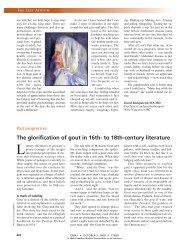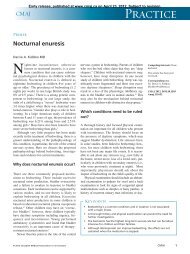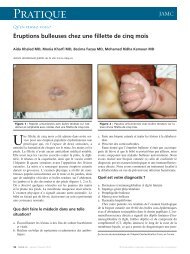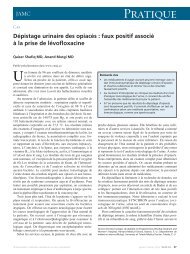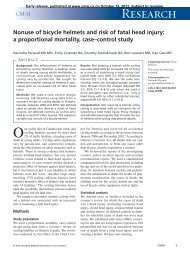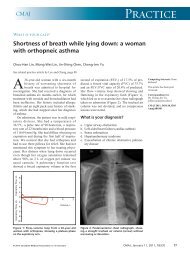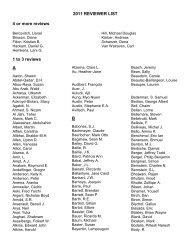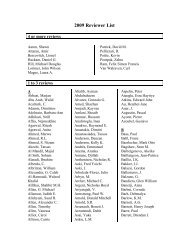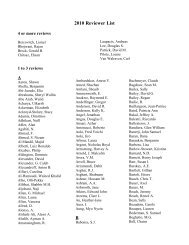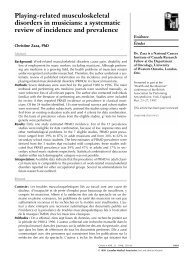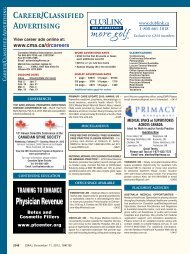Tips for teachers of evidence-based medicine: 1. Relative risk ...
Tips for teachers of evidence-based medicine: 1. Relative risk ...
Tips for teachers of evidence-based medicine: 1. Relative risk ...
You also want an ePaper? Increase the reach of your titles
YUMPU automatically turns print PDFs into web optimized ePapers that Google loves.
<strong>Tips</strong> <strong>for</strong> <strong>teachers</strong> <strong>of</strong> <strong>evidence</strong>-<strong>based</strong> <strong>medicine</strong><br />
Teaching tip 2: Balancing benefits and adverse<br />
effects in individual patients<br />
When to use this tip<br />
This tip is suitable <strong>for</strong> intermediate to advanced learners,<br />
and the exercise requires 10–15 minutes. The general<br />
objective is to help learners apply <strong>evidence</strong> about intervention<br />
benefits and <strong>risk</strong>s to individual patients, with the following<br />
specific objectives:<br />
• Learn how to use a known relative <strong>risk</strong> reduction to estimate<br />
the <strong>risk</strong> <strong>of</strong> an event <strong>for</strong> a patient undergoing<br />
treatment, given an estimate <strong>of</strong> that individual’s <strong>risk</strong> <strong>of</strong><br />
the event without treatment.<br />
• Learn how to use <strong>risk</strong> differences (absolute <strong>risk</strong> reductions)<br />
to assess whether the benefits <strong>of</strong> therapy outweigh<br />
its harms.<br />
The script<br />
Walk the learners through the following hypothetical<br />
scenario. Each learner should imagine himself or herself as<br />
a family physician who is seeing Pat, a 69-year-old woman<br />
whose blood pressure during a routine examination is<br />
170/100 mm Hg. When Pat is seen again in a few weeks,<br />
her blood pressure is unchanged. She is otherwise well and<br />
has no history <strong>of</strong> cardiovascular or cerebrovascular disease.<br />
Tell the learners that they assess Pat’s <strong>risk</strong> <strong>of</strong> stroke at<br />
about 1% (or 1 in 100) per year. 9<br />
Tell the learners that a recent randomized trial <strong>of</strong> a<br />
newly released antihypertensive drug, drug X, reported a<br />
relative <strong>risk</strong> reduction <strong>for</strong> stroke <strong>of</strong> 33% over 3 years. Ask<br />
them to calculate Pat’s <strong>risk</strong> <strong>of</strong> stroke over 3 years with and<br />
without treatment with drug X. (Her <strong>risk</strong> over 3 years is<br />
3% without treatment and 2% with treatment, a <strong>risk</strong> difference<br />
<strong>of</strong> 1%.)<br />
Next, tell the learners about Dorothy, who is also 69<br />
years old and whose blood pressure is the same as Pat’s,<br />
170/100 mm Hg. However, because Dorothy had a<br />
stroke recently, the hypothetical physician assesses her<br />
<strong>risk</strong> <strong>of</strong> subsequent stroke as substantially greater than<br />
Pat’s, perhaps 10% per year. 10 Now, ask the learners to<br />
calculate the <strong>risk</strong> difference <strong>for</strong> Dorothy over 3 years,<br />
with and without drug X, using the same relative <strong>risk</strong> reduction<br />
(33%). You can use a blank version <strong>of</strong> Table 1<br />
to help learners determine the potential benefit <strong>of</strong> the<br />
drug. Insert the estimated 3-year event rates <strong>for</strong><br />
Dorothy and then apply the relative <strong>risk</strong> reduction<br />
(33%) expected if she takes drug X. It should be evident<br />
that Dorothy’s <strong>risk</strong> over 3 years falls from 30% to 20%,<br />
a <strong>risk</strong> difference <strong>of</strong> 10%.<br />
Finally, remind the learners that they need to factor any<br />
potential harms (adverse effects associated with using the<br />
drug) into their clinical decisions. You can tell them that in<br />
the clinical trials <strong>of</strong> drug X, the <strong>risk</strong> <strong>of</strong> severe gastric bleeding<br />
increased 3-fold over 3 years in patients who received<br />
the drug (a relative <strong>risk</strong> <strong>of</strong> 3). You can also tell them that a<br />
population-<strong>based</strong> study has reported the <strong>risk</strong> <strong>of</strong> severe gastric<br />
bleeding <strong>for</strong> women in your patients’ age group at<br />
about 0.1% per year (regardless <strong>of</strong> their <strong>risk</strong> <strong>of</strong> stroke).<br />
Have them work out the <strong>risk</strong> <strong>of</strong> severe gastric bleeding <strong>for</strong><br />
both Pat and Dorothy over 3 years with and without treatment<br />
with drug X. They should find that the <strong>risk</strong> is 0.3%<br />
without treatment and 0.9% with treatment, an absolute<br />
difference <strong>of</strong> 0.6%.<br />
By now, your learners should have filled in the table to<br />
look like Table <strong>1.</strong><br />
Ask them whether, given the results <strong>of</strong> this exercise,<br />
they would give drug X to Pat, to Dorothy or to both.<br />
You can anticipate that the discussion will ensue along the<br />
following lines. Pat will experience a small benefit (<strong>risk</strong><br />
difference over 3 years <strong>of</strong> about 1% <strong>for</strong> stroke), but this<br />
will be considerably <strong>of</strong>fset by the increased <strong>risk</strong> <strong>of</strong> gastric<br />
bleeding (<strong>risk</strong> difference over 3 years <strong>of</strong> 0.6%). The potential<br />
benefit <strong>for</strong> Dorothy (<strong>risk</strong> difference over 3 years <strong>of</strong><br />
about 10%) is much greater than the increased <strong>risk</strong> <strong>of</strong><br />
harm (<strong>risk</strong> difference over 3 years <strong>of</strong> 0.6%). There<strong>for</strong>e,<br />
the net benefit <strong>of</strong> treatment is likely to be greater <strong>for</strong><br />
Dorothy (who is at higher <strong>risk</strong> <strong>of</strong> stroke) than <strong>for</strong> Pat<br />
(who is at lower <strong>risk</strong>). Learners may also notice that assessment<br />
<strong>of</strong> the balance between benefits and harms de-<br />
Table 1: Benefit and harm table, as completed by learners (tip 2)<br />
3-yr event rate <strong>for</strong> stroke, %<br />
3-yr event rate <strong>for</strong> severe gastric<br />
bleeding, %<br />
Patient group<br />
No<br />
treatment<br />
With<br />
treatment<br />
(drug X)<br />
Absolute <strong>risk</strong><br />
reduction<br />
(no treatment –<br />
treatment)<br />
No<br />
treatment<br />
With<br />
treatment<br />
(drug X)<br />
Absolute <strong>risk</strong><br />
increase<br />
(treatment – no<br />
treatment)<br />
At lower <strong>risk</strong><br />
(e.g., Pat) 3 2 1 0.3 0.9 0.6<br />
At higher <strong>risk</strong><br />
(e.g., Dorothy) 30 20 10 0.3 0.9 0.6<br />
*Based on data from randomized controlled trials <strong>of</strong> drug X reporting a 33% relative <strong>risk</strong> reduction <strong>for</strong> the outcome (stroke) over 3 years and a 3-fold increase <strong>for</strong> the<br />
adverse effect (severe gastric bleeding) over the same period.<br />
CMAJ • AUG. 17, 2004; 171 (4)<br />
Online-3



